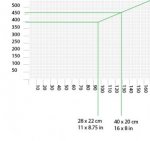turtleowurtle
New member
- Joined
- Mar 28, 2018
- Messages
- 3
please help by providing an excel equation for a "price per square cm" problem
Hi everyone,
I'm terrible at maths, so don't know if this is even the right thread for my problem but here goes...
I am a painter. I want the price of my paintings to scale in a linear fashion, but don't want to charge a set amount per square cm. I want the price to decrease as the painting size increases in a straight, linear line.
My cheapest painting is £395 for a 28 x 23cm painting with an area of 644cm2
My most expensive painting is £2950 for a 90 x 90cm painting with an area of 8100cm2
Please tell me the formula I can use in excel to input any value for the cm squared area, that tells me the price for that size.
Thanks!
Hi everyone,
I'm terrible at maths, so don't know if this is even the right thread for my problem but here goes...
I am a painter. I want the price of my paintings to scale in a linear fashion, but don't want to charge a set amount per square cm. I want the price to decrease as the painting size increases in a straight, linear line.
My cheapest painting is £395 for a 28 x 23cm painting with an area of 644cm2
My most expensive painting is £2950 for a 90 x 90cm painting with an area of 8100cm2
Please tell me the formula I can use in excel to input any value for the cm squared area, that tells me the price for that size.
Thanks!


